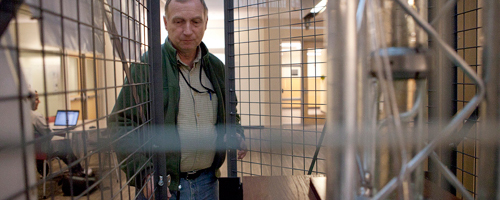Portland State’s Engineering Building is now home to the world’s tallest barometer. The barometer, made of recycled glass tubing and protected by metal trusses, hugs the building’s staircase and rises out of the basement to the second floor, where it measures the atmospheric pressure in the glass atrium of the building.
World’s tallest barometer measures up at PSU
[portfolio_slideshow id=46897]
Portland State’s Engineering Building is now home to the world’s tallest barometer.
The barometer, made of recycled glass tubing and protected by metal trusses, hugs the building’s staircase and rises out of the basement to the second floor, where it measures the atmospheric pressure in the glass atrium of the building.
Its fluid column reaches a record height of 40.5 feet.
Tom Bennett, a civil engineering technician at the Maseeh College of Engineering and Computer Science, conceived the idea in 2011 in the aftermath of two key events: the remodeling of the old chemistry lab, which began in 2009, and the civil engineering department’s creation of a new fluids lab in 2011.
“The glass piping that was used for the barometer was part of the chemistry lab’s drain pipes,” Bennett said. “When the labs got remodeled, I had access to these long, expensive glass pipes, two inches in diameter and 10 feet long. At the same time, in the new fluids lab, we were using a six-foot-tall water barometer for demonstrations. This is when the idea entered my mind,” he said.
Why the world’s tallest barometer?
“If you want to make a really accurate barometer, you make it as tall as possible,” he said.
A taller barometer allows for the more precise detection of pressure differences.
“This may be the ideal way to measure the accuracy of an electronic barometer,” Bennett said.
Barometers are devices that measure atmospheric pressure. In the past they were made with mercury because of its high density. Now they are commonly made digitally or, when needed for lab demonstrations or educational purposes, with water. This unique barometer, however, is made with vacuum pump oil.
Vacuum pump oil is conducive to the functions of a giant barometer because of two principles: vapor pressure and density.
“The oil can be pulled to much greater heights because it does not evaporate as easily as water,” explained Zdenek Zumr, a SWEETLab engineer who was involved in the project. “This particular oil can easily climb up to 40 feet because it is a lighter liquid. The vacuum oil is ideal for a barometer this size.”
Zumr was one of 17 others involved in the project and was responsible for designing the support clamps that centered the glass pipes in the aluminum lattice, as well as for the measurement devices that can be read at the base frame of the barometer.
“One of the goals is to illustrate the many different systems by which atmospheric pressure can be measured,” Zumr said. “Because this barometer serves an educational purpose, we want to show universal units of measurement.”
When the barometer is completed, people should be able to see relations not only between feet and meters but also between the many units that measure atmospheric pressure, including psi, inches of mercury and millibars, to name a few.
Hopefully, the barometer will inspire student interest in science and engineering, Zumr said.
Hank Chiu, a graduate student at PSU, was also involved in the construction of the barometer. He was responsible for cutting out o-rings, which are used to create a watertight seal that contains the fluid in the reservoir.
“As engineer[ing] students, we learn how to do things like cut out o-rings, but to actually apply this knowledge and these skills in a project like this feels really good,” Chiu said.
The barometer, as part of the fluids lab, will allow engineering students in the future to get more precise and accurate measurements—some of the most precise measurements available, in fact.
The official proposal for the barometer went out in March 2012. After approval, parts for the barometer’s construction began to arrive, in December. In January, Bennett went through a permit process for the City of Portland. Shortly thereafter, the barometer was erected in two days. Half of the funding came from the civil engineering department and the other half came from the dean’s matching funds.
All of the 17 students, faculty and staff involved in construction volunteered their time.
“By the sheer fact that this was volunteer effort and made mostly out of recycled material, it embodies the Portland State spirit. It’s just amazing,” Zumr said.







I took a little physics in college. Your project is totally exciting to me. I have wanted to build one similar. Is it up and running? Is the public able to see it work?